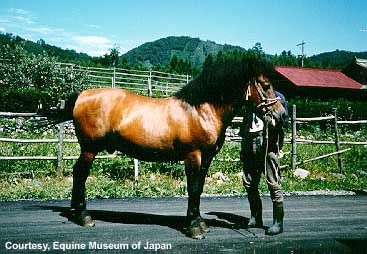
Kiso

Introduction: If you have any comments or suggestions, please click here.
Names: Kiso, Kiso Horse. They took their name from the Kiso region of Nagano Prefecture, the part of Japan where they originated.
Origin: The exact origin of the Kiso and other ancient horse breeds of Japan is uncertain. The Kiso horse has inhabited Japan for about one thousand years.
Breeding: They
are believed to be descended from either the plateau horses of Central Asia or
the Mongolian
horses of the grasslands. During the Meiji Era, Kiso horses were
crossbred with many western breeds and the pure strain virtually disappeared. The
breed is being preserved in the region centering on Kaida mura in Kiso County,
Nagano Prefecture. There are today 117 Kiso horses, which are often seen in
processions in local festivals. Somewhere between
1850 and 1900, breeding small purebreds was discouraged in favor of large
crossbreds. The Kiso was effected more dramatically by this because it was the traditional
military horse; others were primarily used for agricultural purposes. One
source says that their population status is rare.
Between 1600 and 1850 there was more emphasis on
military use, and records from this time regarding the ancient types have been a
valuable aid to modern horse breeders. The existence of the
breed is mainly due to a holy horse at a Shinto shrine-- this and another mare
gave birth to the last of the pure Kiso in 1951. The present Kiso is a
back-bred breed Some ranches in Japan specialize in Kiso or other Japanese
horses.
(The above was inputted before I began citing the dates of my
sources. I am not sure when "today" was; my guess is that it was
written in the 1970's or 80's.)
Description: They have been described as being similar in appearance to the Przewalski or Mongolian; some have a dorsal stripe--which is one criteria for measuring the pureness of a Kiso.
Size: Medium sized; about 13 hands high.
Temperament: Quite similar to the Tarpan.
Features:
Uses: In old Japan, it was a military horse. Today, they are used as riding horses. In the past, it has also been an indispensable aid for farm use, transportation, and power.
Accomplishments:
Curiosities: In the 12th century, warrior Yashinaka Kiso reportedly had 10,000 horse soldiers.
Profiles:
Conclusion: